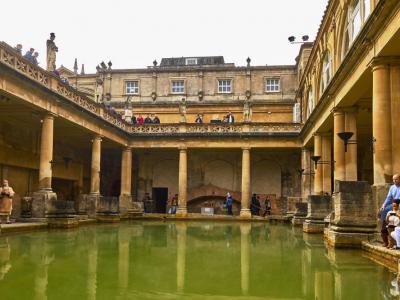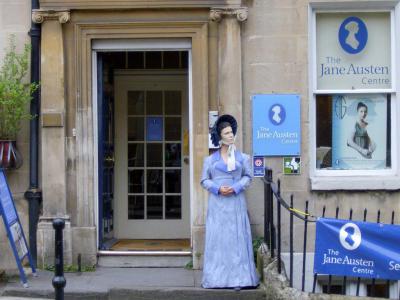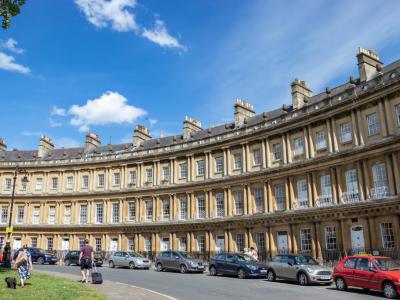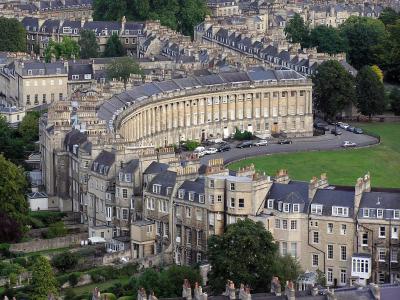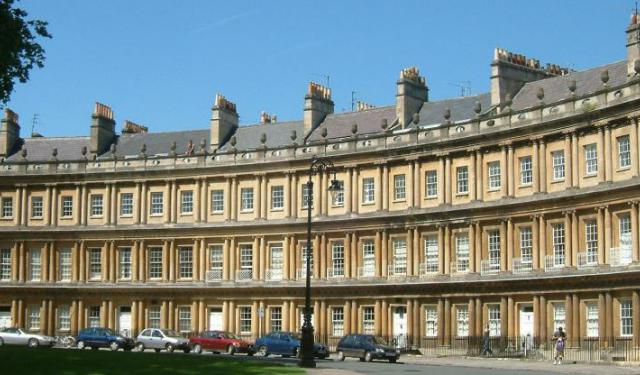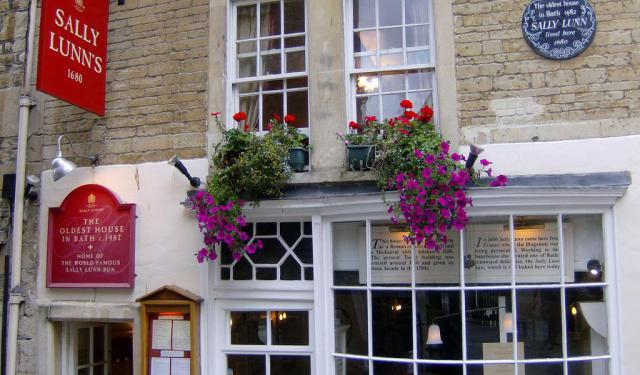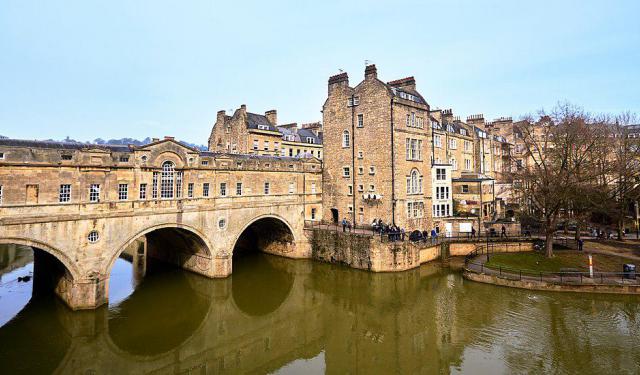
Bath Introduction Walking Tour (Self Guided), Bath
The only English city designated a UNESCO World Heritage site, Bath is a gorgeous city packed with history. Artifacts have been found from the Bronze and Iron Age in the surrounding hills. The Romans were the first to build around the remarkable hot mineral springs at the beginning of the first century. They constructed a temple and baths here, and since then, people have flocked to Bath for its healing waters. The Roman Baths are still one of the most popular tourist attractions in the region, drawing thousands each year.
Bath Abbey, the last great Gothic medieval church built in England, has a notable history and architectural appeal. King Edgar the Peaceful was crowned here in 973. The city underwent a significant transformation during Georgian times, and much of its iconic architecture, like The Circus and The Royal Crescent, are from that era. Pulteney Bridge, another of the town's most prominent landmarks, is one of the few shopping bridges in the world.
You'll also enjoy green spaces, like Victoria Park, Parade Gardens, and Sydney Gardens. If you feel hungry, stop at Sally Lunn's Bunns for an iconic, local, and unique teatime treat.
Jane Austen, the famous 18th-century writer, lived in Bath and set two of her novels in the city. You can learn more about Austen and her character's lives, which provide an incredible historical insight into life in Bath during the Regency period, at the Jane Austen Centre. You can also visit one of Austen's houses and see some sites used in her novels. Fans will love imagining themselves dancing with Mr. Tilney in the Upper Assembly Rooms or shopping along Milsom Street in the footsteps of Anne Elliot.
Just walking the cobblestone streets is a great way to soak up Bath's impressive history. Explore the most notable sights of Bath by taking this self-guided walking tour.
Bath Abbey, the last great Gothic medieval church built in England, has a notable history and architectural appeal. King Edgar the Peaceful was crowned here in 973. The city underwent a significant transformation during Georgian times, and much of its iconic architecture, like The Circus and The Royal Crescent, are from that era. Pulteney Bridge, another of the town's most prominent landmarks, is one of the few shopping bridges in the world.
You'll also enjoy green spaces, like Victoria Park, Parade Gardens, and Sydney Gardens. If you feel hungry, stop at Sally Lunn's Bunns for an iconic, local, and unique teatime treat.
Jane Austen, the famous 18th-century writer, lived in Bath and set two of her novels in the city. You can learn more about Austen and her character's lives, which provide an incredible historical insight into life in Bath during the Regency period, at the Jane Austen Centre. You can also visit one of Austen's houses and see some sites used in her novels. Fans will love imagining themselves dancing with Mr. Tilney in the Upper Assembly Rooms or shopping along Milsom Street in the footsteps of Anne Elliot.
Just walking the cobblestone streets is a great way to soak up Bath's impressive history. Explore the most notable sights of Bath by taking this self-guided walking tour.
How it works: Download the app "GPSmyCity: Walks in 1K+ Cities" from Apple App Store or Google Play Store to your mobile phone or tablet. The app turns your mobile device into a personal tour guide and its built-in GPS navigation functions guide you from one tour stop to next. The app works offline, so no data plan is needed when traveling abroad.
Bath Introduction Walking Tour Map
Guide Name: Bath Introduction Walking Tour
Guide Location: England » Bath (See other walking tours in Bath)
Guide Type: Self-guided Walking Tour (Sightseeing)
# of Attractions: 10
Tour Duration: 2 Hour(s)
Travel Distance: 2.5 Km or 1.6 Miles
Author: rose
Sight(s) Featured in This Guide:
Guide Location: England » Bath (See other walking tours in Bath)
Guide Type: Self-guided Walking Tour (Sightseeing)
# of Attractions: 10
Tour Duration: 2 Hour(s)
Travel Distance: 2.5 Km or 1.6 Miles
Author: rose
Sight(s) Featured in This Guide:
- Pulteney Bridge
- Bath Abbey
- Roman Baths
- Sally Lunn's Historic Eating House
- Bath Street
- Theatre Royal
- Jane Austen Centre
- The Circus
- Royal Crescent
- Royal Victoria Park
1) Pulteney Bridge (must see)
Bath is a city of unique landmarks, and none are more recognizable than the Pulteney Bridge. Depending on who you trust, there are only one, two, or three other bridges in the world that are lined with shops. Whatever the exact number is, there certainly aren't many others like it.
The bridge opened in 1774 and was designed by Robert Adam. The bridge was the brainchild of William Johnstone Pulteney, who named it after his wife, Frances. His vision was to create a new town nearby, but he needed a grand bridge to connect it to Bath. Adam's design was drafted in the Palladian style, harking back to the 16th-century Venetian architect Andrea Palladio.
The Pulteney Bridge is a World Heritage Site and an English Grade I Listed Building. You will find restaurants of various cuisines, independent shops, and Bath Rugby Club's official store along the bridge. The roadway is a busy thoroughfare through Bath to this day.
The best views of the bridge are actually from the south side, either from the Parade Gardens or the Beazer Garden Maze.
To the south, the River Avon flows over the crescent weir. The shops on the north side were heavily altered and expanded by these owners in the 18th and 19th centuries. Their cantilevered floorplans show in stark contrast to the beautiful Georgian stone bridge as viewed from the south.
The bridge opened in 1774 and was designed by Robert Adam. The bridge was the brainchild of William Johnstone Pulteney, who named it after his wife, Frances. His vision was to create a new town nearby, but he needed a grand bridge to connect it to Bath. Adam's design was drafted in the Palladian style, harking back to the 16th-century Venetian architect Andrea Palladio.
The Pulteney Bridge is a World Heritage Site and an English Grade I Listed Building. You will find restaurants of various cuisines, independent shops, and Bath Rugby Club's official store along the bridge. The roadway is a busy thoroughfare through Bath to this day.
The best views of the bridge are actually from the south side, either from the Parade Gardens or the Beazer Garden Maze.
To the south, the River Avon flows over the crescent weir. The shops on the north side were heavily altered and expanded by these owners in the 18th and 19th centuries. Their cantilevered floorplans show in stark contrast to the beautiful Georgian stone bridge as viewed from the south.
2) Bath Abbey (must see)
The Abbey Church of Saint Peter and Saint Paul, commonly referred to as Bath Abbey, is a parish church of the Church of England and used to be a Benedictine monastery in Bath. It was established in the 7th century, underwent reorganization in the 10th century, and was reconstructed in the 12th and 16th centuries. A significant restoration project led by Sir George Gilbert Scott took place in the 1860s.
This church is a notable example of Perpendicular Gothic architecture in the West Country. In the past, it also served as a cathedral for a period but later, after disputes between church officials in Bath and Wells, the Diocese of Bath and Wells was centered at Wells Cathedral. The Benedictine community that resided here was disbanded in 1539 during the Dissolution of the Monasteries.
The church has a cruciform design and can accommodate up to 1,200 worshippers. In addition to being an active place of worship, it hosts various civic events, concerts, and lectures. There's a museum showcasing its heritage in the basement.
Bath Abbey is recognized as a Grade I listed building, with a notable feature being its impressive fan vaulting. Inside, you can find war memorials dedicated to the local population and monuments honoring several significant individuals, including wall and floor plaques and commemorative stained glass windows. The church houses two organs and a set of ten bells. On its west front, you can see sculptures depicting angels ascending to heaven on two stone ladders, symbolizing Jacob's Ladder.
Why You Should Visit:
The Abbey is a gorgeous historic building that is worth seeing in its own right. The church is 225 feet long and 80 feet wide.
About 80 percent of the Abbey's wall space is dedicated to windows; the stained glass is spectacular! Specifically, look out for the King Edgar Window, which shows the crowning of King Edgar the Peaceful, and The Great East Window, which shows the story of Jesus in 53 scenes.
Tips:
Keep an eye out for the 635 various memorials on the walls throughout the Abbey.
You can spend a few minutes or an hour and more exploring the Abbey. If you only have 15 minutes, you can take a quick walk, admire the windows and carved angels, and see the fan vaulted ceilings. If you have time for a more extended tour, you can spend more time reading the memorials or reflect or pray in the chapels.
Keep an ear open for the impressive Klais Organ that is played every Sunday and for regular recitals. Organs have been played in the Abbey since 1634, though the current model is newer. The organ was entirely rebuilt by Klais in 1997, using many parts from historical instruments in the building.
Look for the sculpture on the west side of Jacob's Ladder, complete with angels climbing to heaven.
This church is a notable example of Perpendicular Gothic architecture in the West Country. In the past, it also served as a cathedral for a period but later, after disputes between church officials in Bath and Wells, the Diocese of Bath and Wells was centered at Wells Cathedral. The Benedictine community that resided here was disbanded in 1539 during the Dissolution of the Monasteries.
The church has a cruciform design and can accommodate up to 1,200 worshippers. In addition to being an active place of worship, it hosts various civic events, concerts, and lectures. There's a museum showcasing its heritage in the basement.
Bath Abbey is recognized as a Grade I listed building, with a notable feature being its impressive fan vaulting. Inside, you can find war memorials dedicated to the local population and monuments honoring several significant individuals, including wall and floor plaques and commemorative stained glass windows. The church houses two organs and a set of ten bells. On its west front, you can see sculptures depicting angels ascending to heaven on two stone ladders, symbolizing Jacob's Ladder.
Why You Should Visit:
The Abbey is a gorgeous historic building that is worth seeing in its own right. The church is 225 feet long and 80 feet wide.
About 80 percent of the Abbey's wall space is dedicated to windows; the stained glass is spectacular! Specifically, look out for the King Edgar Window, which shows the crowning of King Edgar the Peaceful, and The Great East Window, which shows the story of Jesus in 53 scenes.
Tips:
Keep an eye out for the 635 various memorials on the walls throughout the Abbey.
You can spend a few minutes or an hour and more exploring the Abbey. If you only have 15 minutes, you can take a quick walk, admire the windows and carved angels, and see the fan vaulted ceilings. If you have time for a more extended tour, you can spend more time reading the memorials or reflect or pray in the chapels.
Keep an ear open for the impressive Klais Organ that is played every Sunday and for regular recitals. Organs have been played in the Abbey since 1634, though the current model is newer. The organ was entirely rebuilt by Klais in 1997, using many parts from historical instruments in the building.
Look for the sculpture on the west side of Jacob's Ladder, complete with angels climbing to heaven.
3) Roman Baths (must see)
The Baths at Bath are fed by a natural spring system. Rain falls on the nearby Mendip Hills, and it flows down through limestone aquifers until it is more than 4,000 meters (13,100 feet) below ground level. Geothermal energy heats and pressurizes the water, which rises to the surface and escapes through natural fissures. The 46-degree Celcius (115-degree Fahrenheit) water bubbles up at more than a million liters (250,000 gallons) per day.
This natural spring has attracted visitors to the area for more than 2,000 years. The Celts worshiped here, and the early Romans dedicated the springs to the goddess Sulis. As such, the Roman name of the town was Aquae Sulis. It is also believed that pre-Roman British king Bladud built the original baths here and that their healing powers cured him and his pigs of leprosy.
Between 60 and 70 AD, the Roman temple was built. The Baths, or thermae, were created over the next 300 years or so. After the Romans withdrew from Britain, their complex fell into disrepair and was gone by the 6th century.
Today the spring is housed inside an 18th-century building designed by John Wood, the Elder, and John Wood, the Younger. The buildings were further expanded during the Victorian era in a similar style. The main entrance is currently through the Grand Pump Room, where visitors drank the waters and many social functions were held.
Why You Should Visit:
The Roman Baths intricately connect all points of Britain's history. The natural spring has been worshipped or visited by every resident and conqueror to pass; a visit to the Baths is a walk through time. The Baths are quintessentially unique to this location, and no visit to Bath would be complete without taking the waters, so to speak.
The site is one of the most popular tourist attractions and one of the finest historical sites you can visit in northern Europe. It is remarkably well preserved, with elements on display from each phase of its history.
Tips:
The museum is the place to go to learn the history of the Baths. There you will find thousands of Roman artifacts from the area, many thrown in the spring as an offering to Sulis.
Most people spend from two to three hours to a half-day touring the Baths and museum.
Unfortunately, you can no longer swim in the Baths. But there are several smaller spas nearby that capitalize on the same spring system, and aquifer-drawn water is still served in the Grand Pump Room.
This natural spring has attracted visitors to the area for more than 2,000 years. The Celts worshiped here, and the early Romans dedicated the springs to the goddess Sulis. As such, the Roman name of the town was Aquae Sulis. It is also believed that pre-Roman British king Bladud built the original baths here and that their healing powers cured him and his pigs of leprosy.
Between 60 and 70 AD, the Roman temple was built. The Baths, or thermae, were created over the next 300 years or so. After the Romans withdrew from Britain, their complex fell into disrepair and was gone by the 6th century.
Today the spring is housed inside an 18th-century building designed by John Wood, the Elder, and John Wood, the Younger. The buildings were further expanded during the Victorian era in a similar style. The main entrance is currently through the Grand Pump Room, where visitors drank the waters and many social functions were held.
Why You Should Visit:
The Roman Baths intricately connect all points of Britain's history. The natural spring has been worshipped or visited by every resident and conqueror to pass; a visit to the Baths is a walk through time. The Baths are quintessentially unique to this location, and no visit to Bath would be complete without taking the waters, so to speak.
The site is one of the most popular tourist attractions and one of the finest historical sites you can visit in northern Europe. It is remarkably well preserved, with elements on display from each phase of its history.
Tips:
The museum is the place to go to learn the history of the Baths. There you will find thousands of Roman artifacts from the area, many thrown in the spring as an offering to Sulis.
Most people spend from two to three hours to a half-day touring the Baths and museum.
Unfortunately, you can no longer swim in the Baths. But there are several smaller spas nearby that capitalize on the same spring system, and aquifer-drawn water is still served in the Grand Pump Room.
4) Sally Lunn's Historic Eating House
Inside one of the oldest houses in Bath, you will find some delectable treats. As the story goes, Sally Lunn was a French immigrant who arrived in Bath in 1680 and established this bakery. The house was built around 1482, but the masonry oven and other elements on the ground floor date from around 1137.
The lower level of the home hosts a museum where you can tour the original kitchen. The house still serves food based on their trademark recipe, the "Sally Lunn Bunn." In the evening, they serve fine English food, including some spectacular pies.
But all is not as it seems at Sally Lunn's Historic Eating House. While the food is excellent, and the house is very old indeed, there is little historical evidence of one Sally Lunn, or Solange Lyon, as the story goes. The building was purchased in the 1930s by the enterprising Marie Byng-Johnson, who opened a tearoom and claimed to subsequently discover an "ancient document" that told Madamoiselle Lunn's story. The "Sally Lunn Bunn" moniker had already long been used to describe the sweet teacake throughout Britain.
Regardless of the details, Sally Lunn Bunns are an iconic Bath original. There's no better place in town to take tea, and there's no better accompaniment than the original teacake. Savory or sweet, with tea or coffee, you can't go wrong. Just don't forget the clotted cream.
The lower level of the home hosts a museum where you can tour the original kitchen. The house still serves food based on their trademark recipe, the "Sally Lunn Bunn." In the evening, they serve fine English food, including some spectacular pies.
But all is not as it seems at Sally Lunn's Historic Eating House. While the food is excellent, and the house is very old indeed, there is little historical evidence of one Sally Lunn, or Solange Lyon, as the story goes. The building was purchased in the 1930s by the enterprising Marie Byng-Johnson, who opened a tearoom and claimed to subsequently discover an "ancient document" that told Madamoiselle Lunn's story. The "Sally Lunn Bunn" moniker had already long been used to describe the sweet teacake throughout Britain.
Regardless of the details, Sally Lunn Bunns are an iconic Bath original. There's no better place in town to take tea, and there's no better accompaniment than the original teacake. Savory or sweet, with tea or coffee, you can't go wrong. Just don't forget the clotted cream.
5) Bath Street (must see)
Spanning the short distance between the Roman Baths and the Cross Bath, Bath Street was built in 1791 by Thomas Baldwin. It was first called Cross Bath Street since it leads to the Cross Bath. In 1688, James II welcomed a son, nine months after his wife, Mary of Modena, bathed in the waters. The cross was erected to celebrate the birth of Prince James. This stamp of royal approval only increased the bath's popularity. Thermae Bath Spa now runs cross Bath.
The historic buildings lining each side of the street are all registered as Grade I listed buildings. It's a lively tourist destination as folks walk between the various sites of Bath. You can see the Abbey in the distance, and the west side of the Roman Baths complex is visible at the end of the road.
Bath Street is lined with shops and restaurants, making it the perfect hub for finding afternoon tea or doing some window shopping. It also acts as a time machine; the absence of shop signs and neon lights will transport you back to Georgian times. It's appealing unchanged architecture make Bath Street a popular backdrop for movie scenes. During the winter holidays, look for the streets to be lined with the Bath Christmas Market festival.
The historic buildings lining each side of the street are all registered as Grade I listed buildings. It's a lively tourist destination as folks walk between the various sites of Bath. You can see the Abbey in the distance, and the west side of the Roman Baths complex is visible at the end of the road.
Bath Street is lined with shops and restaurants, making it the perfect hub for finding afternoon tea or doing some window shopping. It also acts as a time machine; the absence of shop signs and neon lights will transport you back to Georgian times. It's appealing unchanged architecture make Bath Street a popular backdrop for movie scenes. During the winter holidays, look for the streets to be lined with the Bath Christmas Market festival.
6) Theatre Royal
Opened in 1805, The Theatre Royal in Bath remains one of the largest provincial theatres in the UK. Located in the busy Seven Dials area of Bath city centre, the theatre hosts touring plays, musical performances and stand up comedy. The theatre is also the centre of Bath’s renowned Shakespeare Festival, which takes place throughout the month of March. The theatre complex also houses two smaller studio theatres – the Ustinov Studio, which hosts an annual puppetry festival, and The Egg, a newly opened children’s studio which runs regular arts and theatre workshops for children and families.
The Theatre Royal is one of several fine examples of Georgian architecture in the city of Bath. The main theatre building was originally built in 1720, and was designed by architect Thomas Greenway. Local socialite Beau Nash was the first resident of the building, before it was converted into a theatre in the early 19th century. Rebuilt after a fire in 1863, the ornate red and gold interior of the theatre’s 900 seat auditorium was restored as part of a complete overhaul of the theatre in 2010. The Rivals, a play set in Bath’s Georgian heyday, premièred to commemorate the theatre’s restoration and reopening.
The Theatre Royal is one of several fine examples of Georgian architecture in the city of Bath. The main theatre building was originally built in 1720, and was designed by architect Thomas Greenway. Local socialite Beau Nash was the first resident of the building, before it was converted into a theatre in the early 19th century. Rebuilt after a fire in 1863, the ornate red and gold interior of the theatre’s 900 seat auditorium was restored as part of a complete overhaul of the theatre in 2010. The Rivals, a play set in Bath’s Georgian heyday, premièred to commemorate the theatre’s restoration and reopening.
7) Jane Austen Centre (must see)
Nothing typifies Regency life in Bath so much as a classic Jane Austen novel. The world-renown author lived in Bath from 1801 to 1806. Two of her novels, Northanger Abbey and Persuasion, were set here. So it's no surprise that in Bath you will find the Jane Austen Centre. Nestled in a Georgian house near the imposing Bath Abbey, The Circus, and the Roman Baths, this museum aims to share the wonders of Austen's Georgian-era Bath with the world.
The Centre has actors in Regency costume to create an immersive experience. There is a carefully crafted, waxwork statue of Jane. The waxwork often surprises visitors as it stands at 5'8", quite tall for a Georgian lady. Forensic artists spent over three years creating the sculpture. There is only one likeness of Jane Austen; a portrait drawn by her sister, Cassandra. However, other family members criticized the portrait and felt it did not capture the true Jane Austen. See for yourself whether or not the sculpture matches your expectations. You'll also find a gift shop and a tea room operated by the Centre.
Why You Should Visit:
Ardent Jane Austen fans will need no encouragement to stop at the Jane Austen Centre. But the Centre is designed as an immersive experience for the whole family, with guides in period costumes add to the charm. Learn about Bath's history, especially about Regency-era life and customs.
The building itself, part of a block on Gay Street, is an English Heritage Grade II listed building.
Tips:
The Centre organizes Bath's Jane Austen Festival every year in September. The ten-day celebration features over 80 events, including a summer ball, a costumed promenade, and a masquerade ball.
Do not miss the Centre's Regency Tea Room, which has been awarded the Tea Guild's Award of Excellence. If you've visited the Centre, you get 10 percent off at the Tea Room.
The Centre has actors in Regency costume to create an immersive experience. There is a carefully crafted, waxwork statue of Jane. The waxwork often surprises visitors as it stands at 5'8", quite tall for a Georgian lady. Forensic artists spent over three years creating the sculpture. There is only one likeness of Jane Austen; a portrait drawn by her sister, Cassandra. However, other family members criticized the portrait and felt it did not capture the true Jane Austen. See for yourself whether or not the sculpture matches your expectations. You'll also find a gift shop and a tea room operated by the Centre.
Why You Should Visit:
Ardent Jane Austen fans will need no encouragement to stop at the Jane Austen Centre. But the Centre is designed as an immersive experience for the whole family, with guides in period costumes add to the charm. Learn about Bath's history, especially about Regency-era life and customs.
The building itself, part of a block on Gay Street, is an English Heritage Grade II listed building.
Tips:
The Centre organizes Bath's Jane Austen Festival every year in September. The ten-day celebration features over 80 events, including a summer ball, a costumed promenade, and a masquerade ball.
Do not miss the Centre's Regency Tea Room, which has been awarded the Tea Guild's Award of Excellence. If you've visited the Centre, you get 10 percent off at the Tea Room.
8) The Circus (must see)
Originally called the King's Circus, The Circus was finished in 1768. The design was formulated by architect John Wood Sr., but he died during construction, and his son finished the project. The plaza consists of three large townhouse buildings, all forming a perfect circle at the meeting of Brock, Gay, and Bennett Streets. The name "Circus" comes from Latin and means a ring or circle.
John Wood Sr. was known for his appreciation of symbology. He admired the Druids and was convinced that Bath had been the hub of much Druid activity in Britain. As such, he studied Stonehenge and built The Circus with the same diameter. He also included many emblems in the design, with serpents, nautical symbols, acorns, and keys from masonic lore. In all, there are more than 525 pictorial emblems and symbols used. The entire design, when viewed from above, looks like a masonic key. A ley-line joins it to the Royal Crescent, which some believe represents the sun and the moon in their designs.
Many wealthy and famous have lived in The Circus over the years. Thomas Gainsborough lived here in the 1700s, and Nicolas Cage had a flat here for awhile. It's also said that if you wander the center plaza, you can find one precise point where all sound will echo.
The building is a Grade I listed building, and like many others in Bath, it is a fine example of Georgian architecture. Each level's facade is designed in a different classical order—Greek Doric, Roman Composite, and Corinthian.
John Wood Sr. was known for his appreciation of symbology. He admired the Druids and was convinced that Bath had been the hub of much Druid activity in Britain. As such, he studied Stonehenge and built The Circus with the same diameter. He also included many emblems in the design, with serpents, nautical symbols, acorns, and keys from masonic lore. In all, there are more than 525 pictorial emblems and symbols used. The entire design, when viewed from above, looks like a masonic key. A ley-line joins it to the Royal Crescent, which some believe represents the sun and the moon in their designs.
Many wealthy and famous have lived in The Circus over the years. Thomas Gainsborough lived here in the 1700s, and Nicolas Cage had a flat here for awhile. It's also said that if you wander the center plaza, you can find one precise point where all sound will echo.
The building is a Grade I listed building, and like many others in Bath, it is a fine example of Georgian architecture. Each level's facade is designed in a different classical order—Greek Doric, Roman Composite, and Corinthian.
9) Royal Crescent (must see)
The Royal Crescent in Bath is a notable example of Georgian architecture. It comprises 30 terraced houses, designed by John Wood, the Younger, and constructed between 1767 and 1774. Recognized as a Grade I listed building, the Royal Crescent is a testament to the architectural grandeur of its time and remains a significant historical and cultural landmark.
Spanning 500 feet (about 150 meters), the crescent is distinguished by its 114 Ionic columns on the first floor, supporting an entablature designed in the Palladian style. This design element contributes to its classical and elegant appearance. The Royal Crescent holds the distinction of being the first crescent of terraced houses ever built, embodying the concept of "rus in urbe" or "the country in the city," thanks to its overlooking views of the parkland opposite.
Throughout its history of over 240 years, the Royal Crescent has been home to many notable figures, commemorated by plaques on the relevant buildings. The configuration of the crescent has evolved; of the original 30 townhouses, 10 remain full-size, 18 have been converted into flats of various sizes, one serves as the No. 1 Royal Crescent museum, and two (No. 16 and No. 15) now form The Royal Crescent Hotel & Spa.
Constructed primarily from Bath stone, these houses have slate roofs, although they were originally tiled with stone. The external appearance of each house is remarkably similar, with only minor variations such as some featuring small balconettes on the first floor. Many windows have been restored to their original style with glazing bars, replacing the horned plate glass sash windows installed in later centuries. Despite various internal modifications over the years, the Georgian stone facade of the Royal Crescent has been meticulously preserved, maintaining much of its original aesthetic and charm.
Tips:
No. 1 Royal Cresent is a museum. Here you'll find it preserved as a historic house, with rooms, furniture, pictures, and other items depicting Georgian life between 1776 and 1796. Among the fully furnished and appointed rooms you can tour, there is a Parlour, a Gentleman's Retreat, a Withdrawing Room, Servant's Hall, Kitchen, and Scullery.
Spanning 500 feet (about 150 meters), the crescent is distinguished by its 114 Ionic columns on the first floor, supporting an entablature designed in the Palladian style. This design element contributes to its classical and elegant appearance. The Royal Crescent holds the distinction of being the first crescent of terraced houses ever built, embodying the concept of "rus in urbe" or "the country in the city," thanks to its overlooking views of the parkland opposite.
Throughout its history of over 240 years, the Royal Crescent has been home to many notable figures, commemorated by plaques on the relevant buildings. The configuration of the crescent has evolved; of the original 30 townhouses, 10 remain full-size, 18 have been converted into flats of various sizes, one serves as the No. 1 Royal Crescent museum, and two (No. 16 and No. 15) now form The Royal Crescent Hotel & Spa.
Constructed primarily from Bath stone, these houses have slate roofs, although they were originally tiled with stone. The external appearance of each house is remarkably similar, with only minor variations such as some featuring small balconettes on the first floor. Many windows have been restored to their original style with glazing bars, replacing the horned plate glass sash windows installed in later centuries. Despite various internal modifications over the years, the Georgian stone facade of the Royal Crescent has been meticulously preserved, maintaining much of its original aesthetic and charm.
Tips:
No. 1 Royal Cresent is a museum. Here you'll find it preserved as a historic house, with rooms, furniture, pictures, and other items depicting Georgian life between 1776 and 1796. Among the fully furnished and appointed rooms you can tour, there is a Parlour, a Gentleman's Retreat, a Withdrawing Room, Servant's Hall, Kitchen, and Scullery.
10) Royal Victoria Park (must see)
There are landmarks across Great Britain named after its longest serving monarch, Queen Victoria – but Royal Victoria Park was the first to bear her name. Opened in 1830 when the then Princess Victoria was just 11 years old, the 57 acre public park is typical of the municipal gardens that appeared in wealthy cities in the 19th century. Aiming to offer entertainment, social spaces and the tranquility of nature within one space, the park is a popular destination for tourists and local residents to this day.
Royal Victoria Park is situated to the northwest of the city, a ten minute walk from the center. The Royal Crescent is five minutes away, and overlooks the park from the edge of Lansdown Hill. The park boasts an extensive ornamental garden with a monument to Victoria at its center. A boating pond is a popular spot to spend an afternoon, whilst the large public playground is perhaps the park’s highlight. A large, constantly updated collection of unique and creative play equipment caters for all ages, from sand pits to skateboard ramps. The park hosts several outdoor family events in summer, including the popular Hot Air Balloon festival, when the Bath skyline is lit up by colorful hot air balloons launching from the park.
Royal Victoria Park is situated to the northwest of the city, a ten minute walk from the center. The Royal Crescent is five minutes away, and overlooks the park from the edge of Lansdown Hill. The park boasts an extensive ornamental garden with a monument to Victoria at its center. A boating pond is a popular spot to spend an afternoon, whilst the large public playground is perhaps the park’s highlight. A large, constantly updated collection of unique and creative play equipment caters for all ages, from sand pits to skateboard ramps. The park hosts several outdoor family events in summer, including the popular Hot Air Balloon festival, when the Bath skyline is lit up by colorful hot air balloons launching from the park.
Walking Tours in Bath, England
Create Your Own Walk in Bath
Creating your own self-guided walk in Bath is easy and fun. Choose the city attractions that you want to see and a walk route map will be created just for you. You can even set your hotel as the start point of the walk.
Georgian Architecture Walking Tour
Another prominent attraction of Bath is its wonderful Georgian architecture. Many a street and square here are richly adorned with distinctively stylish buildings. In large part, the city owes it to two architects – father and son: John Wood, the Elder, and John Wood, the Younger. Constructed mostly from Bath Stone, a creamy limestone obtained in Combe Down and Bathampton Down Miles, these... view more
Tour Duration: 1 Hour(s)
Travel Distance: 2.2 Km or 1.4 Miles
Tour Duration: 1 Hour(s)
Travel Distance: 2.2 Km or 1.4 Miles
Historical Homes Walking Tour
Apart from its Roman thermae, the city of Bath is renowned for its prominent residents who used to live here a long time ago. Their former dwellings – historical monuments in their own right – now offer a captivating glimpse into the city's glorious past.
Among the most famous of them, undoubtedly, is the Jane Austen Centre. This charming Georgian townhouse provides a fascinating look... view more
Tour Duration: 1 Hour(s)
Travel Distance: 1.6 Km or 1 Miles
Among the most famous of them, undoubtedly, is the Jane Austen Centre. This charming Georgian townhouse provides a fascinating look... view more
Tour Duration: 1 Hour(s)
Travel Distance: 1.6 Km or 1 Miles
Jane Austen Walking Tour
Jane Austen, 1775-1817, was a renowned British author. Her groundbreaking novels offer a witty and humorous look at Regency-era life. Austen's six novels have since inspired many popular TV adaptations and films.
Jane Austen lived in Bath from 1801 to 1806. Two of her novels, Northanger Abbey and Persuasion, were set in this beautiful Georgian city. While interiors have certainly been... view more
Tour Duration: 2 Hour(s)
Travel Distance: 2.5 Km or 1.6 Miles
Jane Austen lived in Bath from 1801 to 1806. Two of her novels, Northanger Abbey and Persuasion, were set in this beautiful Georgian city. While interiors have certainly been... view more
Tour Duration: 2 Hour(s)
Travel Distance: 2.5 Km or 1.6 Miles
The Most Popular Cities
/ view all


